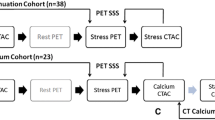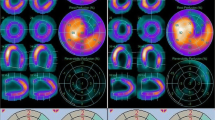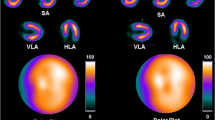Abstract
Purpose
To evaluate the use of CT attenuation maps, generated from coronary calcium scoring (CCS) scans at in- and expiration with a 64-slice CT scanner, for attenuation correction (AC) of myocardial perfusion SPECT images.
Methods
Thirty-two consecutive patients underwent 99mTc-tetrofosmin gated adenosine stress/rest SPECT scan on an Infinia Hawkeye SPECT-CT device (GE Medical Systems) followed by CCS and CT angiography on a 64-slice CT. AC of the iteratively reconstructed images was performed with AC maps obtained: (a) from the “Hawkeye” low-resolution X-ray CT facility attached to the Infinia camera (IRAC); (b) from the CCS scan acquired on a 64-slice CT scanner during maximal inspiration (ACINSP) and (c) during normal expiration (ACEXP). Automatically determined uptake values of stress scans (QPS, Cedars Medical Sinai) from ACINSP and ACEXP were compared with IRAC. Agatston score (AS) values using ACINSPversus ACEXP were also compared.
Results
ACINSP and ACEXP resulted in identical findings versus IRAC by visual analysis. A good correlation for uptake values between IRAC and ACINSP was found (apex, r=0.92; anterior, r=0.85; septal, r=0.91; lateral, r=0.86; inferior, r=0.90; all p<0.0001). The correlation was even closer between IRAC and ACEXP (apex, r=0.97; anterior, r=0.91; septal, r=0.94; lateral, r=0.92; inferior, r=0.97; all p<0.0001). The mean AS during inspiration (319±737) and expiration(317±778) was comparable (p=NS).
Conclusion
Attenuation maps from CCS allow accurate AC of SPECT MPI images. ACEXP proved superior to ACINSP, suggesting that in hybrid scans CCS may be performed during normal expiration to allow its additional use for AC of SPECT MPI.




Similar content being viewed by others
References
Fleischmann S, Koepfli P, Namdar M, Wyss CA, Jenni R, Kaufmann PA. Gated 99mTc-tetrofosmin SPECT for discriminating infarct from artifact in fixed myocardial perfusion defects. J Nucl Med 2004;45:754–9
Hendel RC, Corbett JR, Cullom SJ, DePuey EG, Garcia EV, Bateman TM. The value and practice of attenuation correction for myocardial perfusion SPECT imaging: a joint position statement from the American Society of Nuclear Cardiology and the Society of Nuclear Medicine. J Nucl Cardiol 2002;9:135–43
Bailey DL, Hutton BF, Walker PJ. Improved SPECT using simultaneous emission and transmission tomography. J Nucl Med 1987;28:844–51
Berman DS, Kiat H, Friedman JD, Wang FP, van Train K, Matzer L, et al. Separate acquisition rest thallium-201/stress technetium-99 m sestamibi dual-isotope myocardial perfusion single-photon emission computed tomography: a clinical validation study. J Am Coll Cardiol 1993;22:1455–64
Ficaro EP, Fessler JA, Shreve PD, Kritzman JN, Rose PA, Corbett JR. Simultaneous transmission/emission myocardial perfusion tomography. Diagnostic accuracy of attenuation-corrected 99mTc-sestamibi single-photon emission computed tomography. Circulation 1996;93:463–73
Bocher M, Balan A, Krausz Y, Shrem Y, Lonn A, Wilk M, et al. Gamma camera-mounted anatomical X-ray tomography: technology, system characteristics and first images. Eur J Nucl Med 2000;27:619–27
Masood Y, Liu YH, Depuey G, Taillefer R, Araujo LI, Allen S, et al. Clinical validation of SPECT attenuation correction using x-ray computed tomography-derived attenuation maps: multicenter clinical trial with angiographic correlation. J Nucl Cardiol 2005;12:676–86
Fricke H, Fricke E, Weise R, Kammeier A, Lindner O, Burchert WA. A method to remove artifacts in attenuation-corrected myocardial perfusion SPECT introduced by misalignment between emission scan and CT-derived attenuation maps. J Nucl Med 2004;45:1619–25
Namdar M, Hany TF, Koepfli P, Siegrist PT, Burger C, Wyss CA, et al. Integrated PET/CT for the assessment of coronary artery disease: a feasibility study. J Nucl Med 2005;46:930–5
O’Connor MK, Kemp B, Anstett F, Christian P, Ficaro EP, Frey E, et al. A multicenter evaluation of commercial attenuation compensation techniques in cardiac SPECT using phantom models. J Nucl Cardiol 2002;9:361–76
Goerres GW, Burger C, Kamel E, Seifert B, Kaim AH, Buck A, et al.Respiration-induced attenuation artifact at PET/CT: technical considerations. Radiology 2003;226:906–10
Utsunomiya D, Nakaura T, Honda T, Shiraishi S, Tomiguchi S, Kawanaka K, et al. Object-specific attenuation correction at SPECT/CT in thorax: optimization of respiratory protocol for image registration. Radiology 2005;237:662–9
Germano G, Kiat H, Kavanagh PB, Moriel M, Mazzanti M, Su HT, et al. Automatic quantification of ejection fraction from gated myocardial perfusion SPECT. J Nucl Med 1995;36:2138–47
Cerqueira MD, Weissman NJ, Dilsizian V, Jacobs AK, Kaul S, Laskey WK, et al. Standardized myocardial segmentation and nomenclature for tomographic imaging of the heart: a statement for healthcare professionals from the Cardiac Imaging Committee of the Council on Clinical Cardiology of the American Heart Association. Circulation 2002;105:539–42
Sharir T, Germano G, Waechter PB, Kavanagh PB, Areeda JS, Gerlach J, et al. A new algorithm for the quantitation of myocardial perfusion SPECT. II: Validation and diagnostic yield. J Nucl Med 2000;41:720–7
Germano G, Kavanagh PB, Waechter P, Areeda J, Van Kriekinge S, Sharir T, et al. A new algorithm for the quantitation of myocardial perfusion SPECT. I: Technical principles and reproducibility. J Nucl Med 2000;41:712–9
Ficaro EP, Fessler JA, Ackermann RJ, Rogers WL, Corbett JR, Schwaiger M. Simultaneous transmission-emission thallium-201 cardiac SPECT: effect of attenuation correction on myocardial tracer distribution. J Nucl Med 1995;36:921–31
Agatston AS, Janowitz WR, Hildner FJ, Zusmer NR, Viamonte M Jr, Detrano R. Quantification of coronary artery calcium using ultrafast computed tomography. J Am Coll Cardiol 1990;15:827–32
Bland JM, Altman DG. Statistical methods for assessing agreement between two methods of clinical measurement. Lancet 1986;1:307–10
Fricke E, Fricke H, Weise R, Kammeier A, Hagedorn R, Lotz N, et al. Attenuation correction of myocardial SPECT perfusion images with low-dose CT: evaluation of the method by comparison with perfusion PET. J Nucl Med 2005;46:736–44.
Wade OL. Movements of the thoracic cage and diaphragm in respiration. J Physiol 1954;124:193–212
Acknowledgements
Philipp A. Kaufmann was supported by a grant from the Swiss National Science Foundation (SNSF professorship grant No. PP00A-68835 and grant No. 31-68386). Hatem Alkadhi and Lotus Desbiolles were supported by the National Center of Competence in Research, Computer Aided and Image Guided Medical Interventions (NCCR CO-ME) of the Swiss National Science Foundation.
We are grateful to our head radiographer, Gabi Hasler, for her excellent technical assistance.
Author information
Authors and Affiliations
Corresponding author
Rights and permissions
About this article
Cite this article
Schepis, T., Gaemperli, O., Koepfli, P. et al. Use of coronary calcium score scans from stand-alone multislice computed tomography for attenuation correction of myocardial perfusion SPECT. Eur J Nucl Med Mol Imaging 34, 11–19 (2007). https://doi.org/10.1007/s00259-006-0173-8
Received:
Accepted:
Published:
Issue Date:
DOI: https://doi.org/10.1007/s00259-006-0173-8




